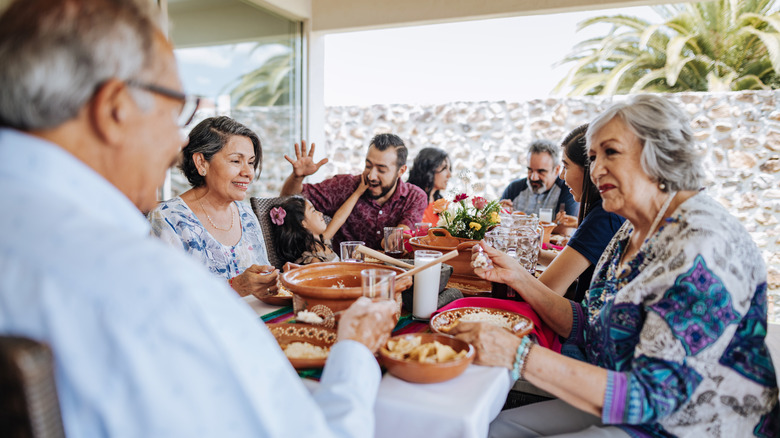Body Language Etiquette Rules Tourists Will Want To Follow When In Mexico
Mexico draws more visitors from the United States than any other country and for good reason. Tourists flock to its sun-splashed beaches, ancient ruins, charming colonial towns, and modern, thrumming metropolises to soak up the country's unique culture and dive into its mouth-watering cuisine. Mexico offers up so much that it would be impossible to see it all in one lifetime, yet that doesn't stop many from trying, though here are ways to avoid making these common mistakes.
With its slower tempos and at times laid-back feel — as found at this secret uncrowded beach town – Mexico can seem like an informal place, which is deceiving. The culture is actually ruled by a set of customs and mores that many visitors may not be aware of, and this includes plenty of nonverbal communication. Simple things like how close you stand or where you put your hands can convey either positive and negative things to your Mexican hosts, so it pays to do a bit of homework before heading out on a trip south of the border.
Be aware of what your body is saying
Mexicans tend to value physical contact, especially when greeting each other. Shaking hands is common in most settings, and this means with everybody in the group. This happens at both the beginning and end of the social engagement, and don't be alarmed if your Mexican acquaintances hold the handshake for longer than you're used to. Closer friends will often say hello and goodbye with a single kiss on the cheek, so yoy may find yourself the recipient of a friendly peck from someone you've already established a relationship with.
People in the U.S. and Canada tend to highly value their "personal space," though this is less of a thing in Mexico. In social situations, Mexicans will often stand close together and talk. While this may make some visitors from north of the border a bit uncomfortable, conveying this to your guests in any way could cause offense, so just take a breath and relax. Also, avoid standing with your hands on your hips — as this could be perceived as anger — and don't put them in your pockets, either. It's just not a good look.
Mexicans very much appreciate politeness, so if you find yourself needing to squeeze by someone in a market, on a crowded sidewalk, or on public transport, make sure to say "con permiso" (with permission) to avoid coming across as rude. If you happen to bump into someone or make any other accidental faux pas, a simple "perdón" (pardon) will almost always suffice.
Keep these manners in mind the table
There are some polite etiquette rules you should keep in mind when dining at a restaurant in Mexico. Similar to dining etiquette in Chile, it is essential to always keep your hands above the table and visible. Don't begin eating until the host declares "Buen provecho" (enjoy your meal), go at a leisurely pace, and never leave the table right after finishing.
A dining rule many visitors to Mexico may not be aware of is that dishes are always passed to the left and knives and forks are never switched: the knife stays in the right hand and the fork in the left. Even if you don't drink alcohol, join in the toasts with water, juice, or soft drinks and cries of "Salud!" Traditionally it is only men who propose toasts, though these sort of gender-based rules have been changing in recent years.
When it comes time to pay, one person — usually the person who extended the invitation — will take care the tab. Splitting the bill is rarely done in Mexico, and the restaurant staff will also expect a 10-15% tip. Complimenting the chef is always good form, and don't show up on time. Mexicans tend to be very relaxed when it comes to punctuality, and you'll probably find yourself waiting, so take it easy.


